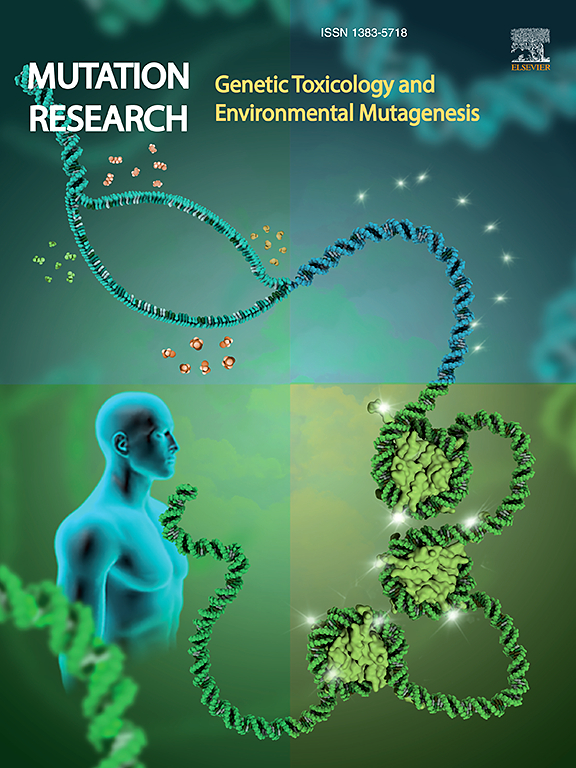Protective role of Cockayne Syndrome B (CSB) protein in maintaining genome integrity in human cells under oxidative stress
IF 2.5
4区 医学
Q3 BIOTECHNOLOGY & APPLIED MICROBIOLOGY
Mutation research. Genetic toxicology and environmental mutagenesis
Pub Date : 2025-09-09
DOI:10.1016/j.mrgentox.2025.503887
引用次数: 0
Abstract
Cockayne Syndrome (CS), a progeroid disorder characterised by premature ageing and neurodevelopmental abnormalities, is primarily caused by mutations in the CSB protein, a key component of the transcription-coupled nucleotide excision repair pathway. This study investigates the role of CSB in managing oxidative DNA damage and preserving telomere integrity under oxidative stress. Using CSB-deficient human fibroblasts (CS-B) and matched controls, we exposed cells to acute and chronic oxidative stress via hydrogen peroxide (H₂O₂) and elevated oxygen (40 %) levels. CS-B fibroblasts showed relative resistance to acute oxidative stress in terms of cell death, maintaining viability and displaying limited cell cycle arrest. In contrast, chronic oxidative exposure induced accelerated senescence in CS-B cells, evidenced by increased telomere attrition, senescent morphology, and early activation of senescence-associated β-galactosidase associated with increased DNA damage and aberrant DNA repair. Gene expression profiling revealed downregulation of key DNA repair and cell cycle genes in CS-B fibroblasts following H₂O₂ treatment, indicating impaired damage response pathways. These findings highlight the essential role of CSB in genome maintenance and suggest that its loss contributes to CS pathology through heightened sensitivity to chronic oxidative stress and telomere dysfunction. This work enhances our understanding of CS-related cellular mechanisms and may inform future therapeutic strategies targeting oxidative stress and DNA repair.
Cockayne综合征B (CSB)蛋白在氧化应激下维持人类细胞基因组完整性中的保护作用
柯凯因综合征(CS)是一种以早衰和神经发育异常为特征的类早衰疾病,主要由CSB蛋白突变引起,CSB蛋白是转录偶联核苷酸切除修复途径的关键成分。本研究探讨了CSB在氧化应激下管理氧化DNA损伤和保持端粒完整性中的作用。使用csb缺陷的人成纤维细胞(CS-B)和匹配的对照,我们通过过氧化氢(H₂O₂)和高氧(40 %)水平将细胞暴露于急性和慢性氧化应激中。CS-B成纤维细胞在细胞死亡、维持活力和有限的细胞周期阻滞方面显示出对急性氧化应激的相对抗性。相反,慢性氧化暴露诱导CS-B细胞加速衰老,这可以通过端粒磨损增加、衰老形态和衰老相关β-半乳糖苷酶的早期激活来证明,该酶与DNA损伤增加和异常DNA修复有关。基因表达谱显示,在h2o2处理后,CS-B成纤维细胞中关键的DNA修复和细胞周期基因下调,表明损伤反应途径受损。这些发现强调了CSB在基因组维持中的重要作用,并表明CSB的缺失通过对慢性氧化应激和端粒功能障碍的敏感性增加而导致CS病理。这项工作增强了我们对cs相关细胞机制的理解,并可能为未来针对氧化应激和DNA修复的治疗策略提供信息。
本文章由计算机程序翻译,如有差异,请以英文原文为准。
求助全文
约1分钟内获得全文
求助全文
来源期刊
CiteScore
3.80
自引率
5.30%
发文量
84
审稿时长
105 days
期刊介绍:
Mutation Research - Genetic Toxicology and Environmental Mutagenesis (MRGTEM) publishes papers advancing knowledge in the field of genetic toxicology. Papers are welcomed in the following areas:
New developments in genotoxicity testing of chemical agents (e.g. improvements in methodology of assay systems and interpretation of results).
Alternatives to and refinement of the use of animals in genotoxicity testing.
Nano-genotoxicology, the study of genotoxicity hazards and risks related to novel man-made nanomaterials.
Studies of epigenetic changes in relation to genotoxic effects.
The use of structure-activity relationships in predicting genotoxic effects.
The isolation and chemical characterization of novel environmental mutagens.
The measurement of genotoxic effects in human populations, when accompanied by quantitative measurements of environmental or occupational exposures.
The application of novel technologies for assessing the hazard and risks associated with genotoxic substances (e.g. OMICS or other high-throughput approaches to genotoxicity testing).
MRGTEM is now accepting submissions for a new section of the journal: Current Topics in Genotoxicity Testing, that will be dedicated to the discussion of current issues relating to design, interpretation and strategic use of genotoxicity tests. This section is envisaged to include discussions relating to the development of new international testing guidelines, but also to wider topics in the field. The evaluation of contrasting or opposing viewpoints is welcomed as long as the presentation is in accordance with the journal''s aims, scope, and policies.

 求助内容:
求助内容: 应助结果提醒方式:
应助结果提醒方式:


